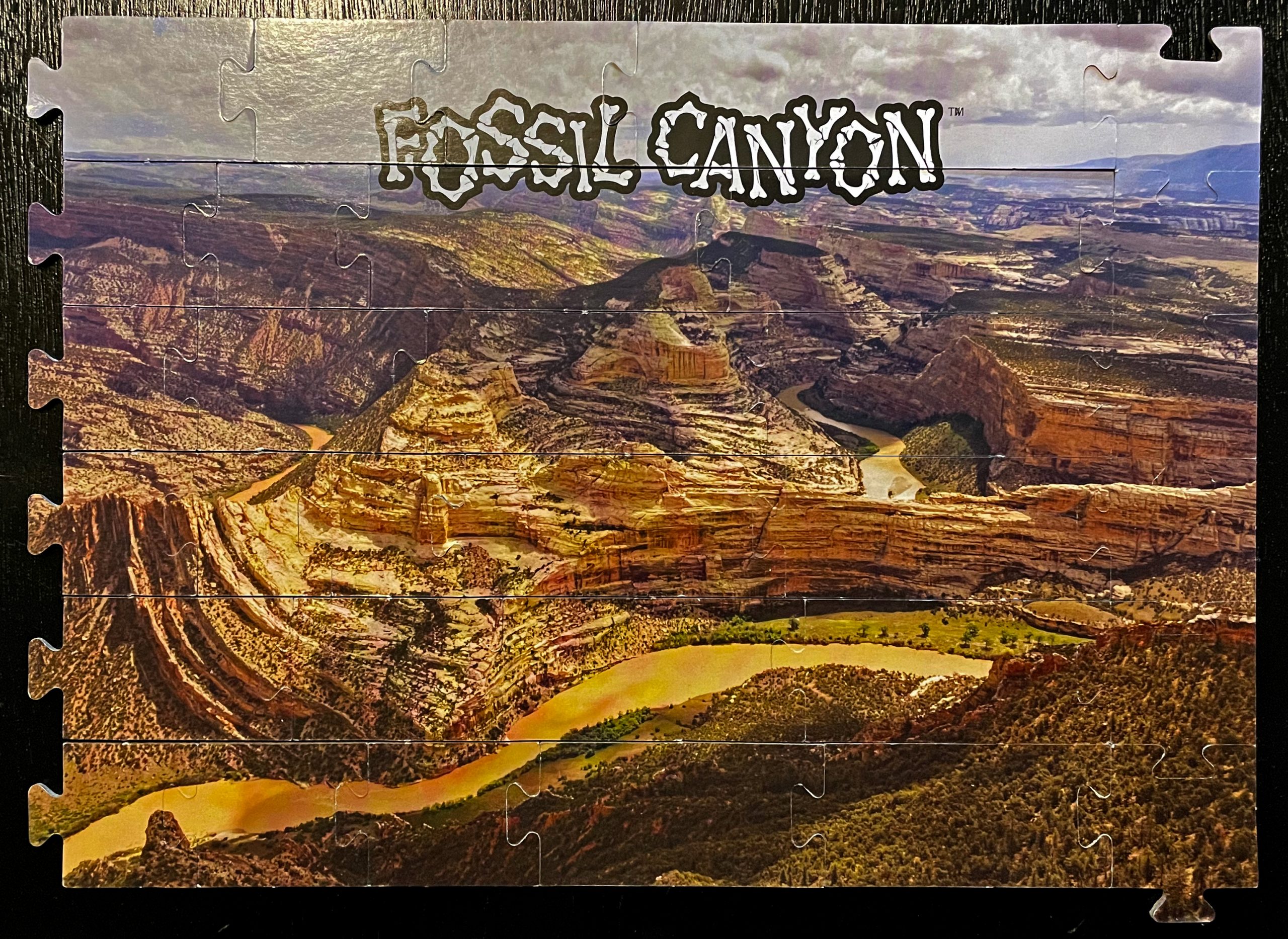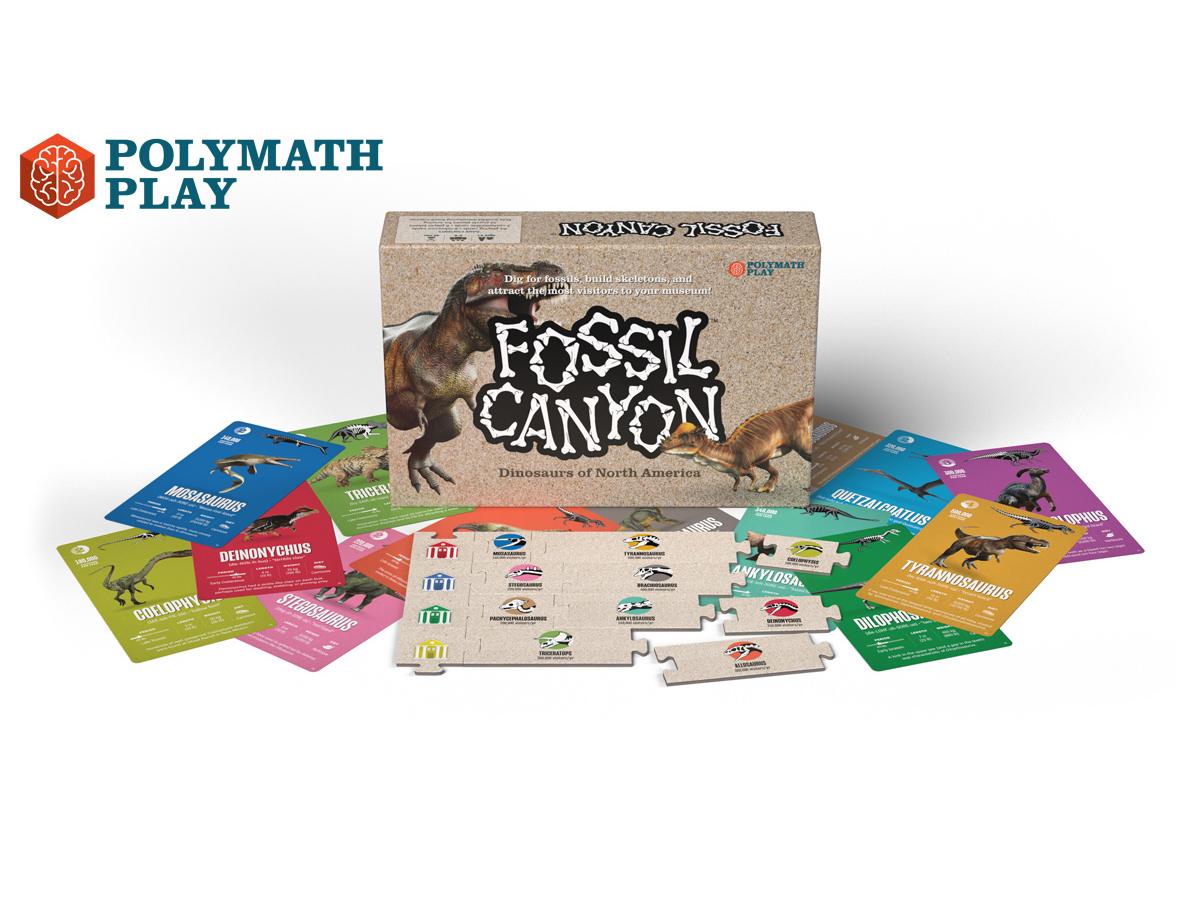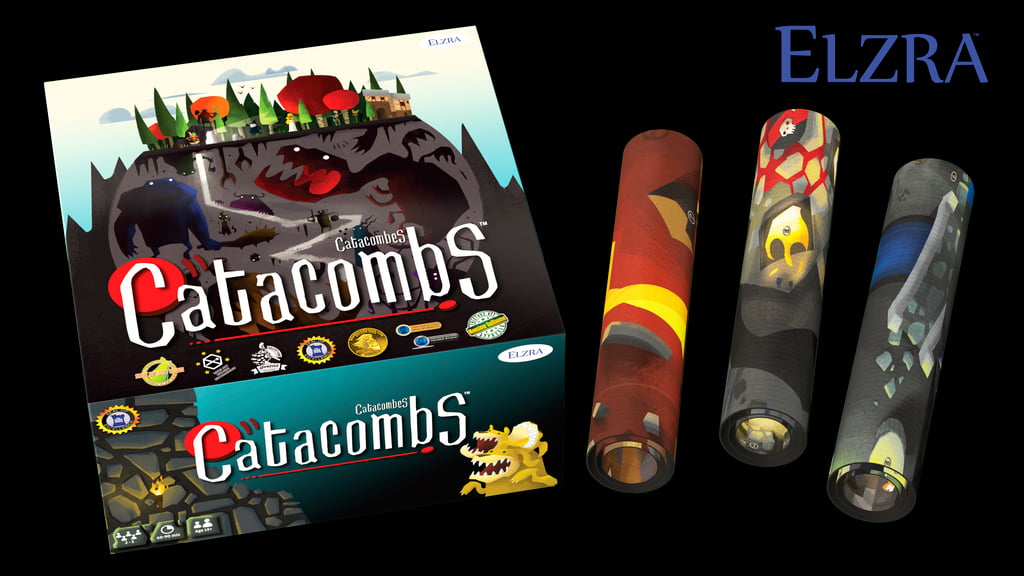I think we can all agree that dinosaurs are almost universally interesting if not exciting for kids, so we jumped at the chance to play and review this latest dino-related game, Fossil Canyon. Fossil Canyon is not only a fun game that blends card management and set collection, bluffing, and press your luck mechanics, but it’s also educational!
What Is Fossil Canyon?
Fossil Canyon is a game for 2-6 players, ages 8 and up, and takes about 30 minutes to play. It’s currently seeking funding on Kickstarter, with a pledge level of $20 for a standard copy of the game or $29 for a deluxe version. The Kickstarter Deluxe Edition will include an upgraded wooden puzzle pieces, a velvet pouch to hold the puzzle pieces, and a deluxe foil-printed box. There are also pledge options for getting multiple copies or even donating copies for educational purposes!
Fossil Canyon was designed by Kevin Lynch and published by Polymath Play, with graphic design by Nathan Martel. Fossil Canyon also enlisted Akiko Shinya from The Field Museum as science advisor.
New to Kickstarter? Check out our crowdfunding primer.
Fossil Canyon Components

Inside the Fossil Canyon box, you’ll find the following components:
- 64 playing cards (58 fossils and 6 actions)
- 6 paleontologist player tokens
- 32 scoring puzzle pieces (6 museums, 23 skeletons, and 3 bonuses)
- 8 helper cards
- Rule book
The cards in the prototype were of a quality I would expect from a finished game and are oversized which is great for fitting the details and dinosaur images, and, for me, great for shuffling because I hate shuffling little cards! The tokens and scoring pieces are all thick cardboard as you’d expect for cardboard game pieces. And, as I always like to note, the game box is the perfect size to fit all of the components neatly without a lot of wasted space or having to worry about the game getting disheveled if the box isn’t handled carefully (very important for a game kids will want to play frequently)!
Note: My review is based on a prototype copy, so it is subject to change and may not reflect final component quality.
How to Play Fossil Canyon
You can download a copy of the rulebook here.
The Goal
The goal of the game is to complete dinosaur fossil skeletons for your museum to attract more visitors than your competing paleontologists.
Setup
Setup usually just takes a few minutes and only varies in the number of starting cards for each player based on the number of players.

Each player picks a color and receives their player token and matching helper card. The matching museum puzzle pieces for each player are attached together to make the scoreboard (one person will act as the scorekeeper and these should be placed beside their play area).
Then all 64 playing cards are shuffled together. Four of the cards are randomly selected and discarded face down – these should remain hidden! These four discarded cards add a bit of uncertainty to what fossil skeletons can actually be completed. The remaining 60 cards are spread out in the middle of the table. This is the Fossil Canyon dig site.
Each player then digs a number of cards based on the number of players in the game and keeps their cards hidden. If a player draws an action card, the card is set aside and a new card dug from the site. Once all players have ONLY fossil cards in their hands, any set aside action cards are mixed back into the dig site.

If any player has the fossil cards to complete a skeleton, they give the fossil cards to the scorekeeper and that skeleton is added to their museum. Completing a skeleton requires one of each piece required for the skeleton. Each card indicates (via a pie chart) how many cards are needed to complete the skeleton and the piece number. For example, if a skeleton requires three pieces, Cards, 1, 2, and 3 are required, not just any 3 cards from that skeleton.
The final step before starting gameplay is for each player to determine their hidden hand versus their public fossils. Each player can have a maximum of three hidden cards but can choose to have fewer or even no hidden cards. This reflects the paleontologist’s professional competitiveness versus scientific openness! Any cards of the same genus should be stacked with their fossil number visible to save space.
Gameplay

Once setup is complete, gameplay goes clockwise from player to player with each player having up to four actions they can perform.
Dig. The player digs a card from the dig site. If the card is a fossil, the player keeps it hidden in their hand. If it’s an action card, the action is performed and the player can dig another card. If the player can complete a skeleton, they give the fossil cards to the scorekeeper and that skeleton is added to their museum.
Trade. Trading is optional, but will likely be done most turns. The player can trade any one of their fossil cards (hidden or showing) with any other player’s fossil card (hidden or showing). If a player has enough cards and wishes to do more trades, they can but each subsequent trade costs an extra card to make, so two cards for a second trade, three for a third, etc. Sometimes it’s worth sacrificing two or three cards to complete a big skeleton, but knowing when and how to make those bigger trades is critical. Trading is where a considerable amount of strategy comes in to Fossil Canyon for not only the person doing the trade but for all the players and how they choose what to show versus hide AND how good your players are at bluffing. For example, my youngest son always goes for the biggest dinosaurs and is very obviously excited if he gets one of those cards and puts it into his hidden hand. If any player (the one doing the trading or the recipient of the trade) completes a skeleton with their newly acquired cards, they give the fossil cards to the scorekeeper and that skeleton is added to their museum.
Collect bonus card. If the player whose turn it is completed any skeletons during digging or trading, they get to dig one bonus card from the dig site. If the player can complete a skeleton, they give the fossil cards to the scorekeeper and that skeleton is added to their museum, but they do not collect any more bonus cards.
Hand adjustment. At the end of a player’s turn, they must adjust their hidden hand back down to the maximum number allowed. Any number of cards can be swapped between hidden or shown, and they can be mixed up before being hidden. One of my personal favorite strategies is to put at least low value card into my hidden hand and “shuffle” them before laying them down so others don’t know where or if there is a good or less good card there for hidden trades. Play then moves to the next player.
Final phase
When there are no more cards in the dig site, the final phase of the game begins. All players place all of their fossil cards face-up. Each turn is now only a single trade. But a player can ONLY trade if they have enough fossils to eventually complete a skeleton (Ex. if a player only has two cards, they cannot trade for a fossil of a three-fossil skeleton as they would never be able to complete that skeleton.) If a player does not have enough cards to complete any remaining skeletons, they are done having a turn but other players can still trade with their cards. Players take turns doing trades until no more skeletons can be completed.
Rule Variations
There are a few rule variations that can make the game easier, shorter, or even more strategic depending on your players.
As mentioned above, three of the action cards have negative actions which might be too disappointing for some younger players, and those can be removed without adversely affecting gameplay to keep the game more positive.
For a shorter game, instead of discarding 4 random cards at the beginning of the game, one three-fossil skeleton, two two-fossil skeletons, and three random cards are discarded for 3 or more players, and three three-fossil skeletons, four two-fossil skeletons, and three random cards are discarded for a two-player game. This results in a game being about half as long as normal.

For an added layer of strategy, you can opt to use the three optional bonus scoring puzzle pieces. There is a large bonus for having at least one of each Cretaceous herbivore skeleton, a medium bonus for the most Jurassic skeletons, and a small bonus for the most carnivore skeletons. We personally haven’t yet tried playing with the bonuses since we’ve played with at least one younger player and didn’t want to play on hard mode yet, but clearly these can potentially help balance out strategies and skeletons players attempt to complete.
Game End

The game ends when there are no cards left in the dig pile and no trades or fossil skeletons left that can be completed. The player with the longest row of puzzle pieces in their museum wins! Ties are broken by which player has the most valuable skeleton.
If you’d like to see a quick video summarizing the gameplay, the folks at Polymath Play put together a nice little video that covers the rules in just a few minutes!
Why You Should Play Fossil Canyon
Fossil Canyon is a fun, easy to learn game for all ages and with the almost universal love of dinosaurs, it’s a game that most players will agree on bringing to the table. With four kids ranging from 5 to 15, it’s almost impossible for us to find a game the entire family can play together and actually enjoy, but Fossil Canyon fits that bill perfectly. While our five-year-old needs a little help, she’s played on both my team and her eight-year-old brother’s team and enjoys the game as much as the rest of the family.

Do you like to come up with your own rules or spice up your games? Fossil Canyon includes two blank cards to use however you’d like to enhance the game. We managed to lose a card already in our many playthroughs so we are using one of them to replace that card until the game gets fully released, but I’d also love to make up our own action or even introduce a wild card to see how that may impact gameplay.
One other cool feature of the game is that Polymath has offered several ideas for alternative games to play with the cards to further expand its playability for a wider range of ages and use as an educational tool. For younger players, there are suggested rules for Go Dig, a game played using the cards similar to Go Fish, as well as a memory game played with the cards laid out face-down and players try to make fossil sets by flipping cards and remembering where they’ve seen them. The difficulty can be increased or decreased based on how many cards and fossils are laid down. And for a slightly more challenging and educational game, 20 questions can be played based on the information about the dinosaurs on the cards, with players trying to guess each others hidden dinosaur cards by asking about the traits of the dinosaur. And they have even promised to post rules for a cooperative version of the game on their website in the near future!
 Another added bonus, especially if you’re a puzzle family, is that all of the scoring puzzle pieces when flipped over actually go together to make a puzzle! It’s a small thing, but the kids loved it when they discovered it, and I admit to a bit of nostalgia from my childhood when card sets would make a puzzle or poster when flipped over (I’m looking at you, Garbage Pail Kids!).
Another added bonus, especially if you’re a puzzle family, is that all of the scoring puzzle pieces when flipped over actually go together to make a puzzle! It’s a small thing, but the kids loved it when they discovered it, and I admit to a bit of nostalgia from my childhood when card sets would make a puzzle or poster when flipped over (I’m looking at you, Garbage Pail Kids!).
And if all of that was not enough to convince you to play Fossil Canyon, there is also a ton of great information about dinosaurs, fossils, and paleontology in the rulebook – in fact the majority of the rule book is actually educational information and a great starting point for learning about dinosaurs and fossils for budding paleontologists, including relative sizes of the dinosaurs in the game, timelines of geological periods, and a listing of books and online resources to dig deeper into the amazing world of paleontology.
For more information or to make a pledge, visit the Fossil Canyon Kickstarter page!
Click here to see all our tabletop game reviews.
![]() To subscribe to GeekDad’s tabletop gaming coverage, please copy this link and add it to your RSS reader.
To subscribe to GeekDad’s tabletop gaming coverage, please copy this link and add it to your RSS reader.
Disclosure: GeekDad received a prototype of this game for review purposes.





